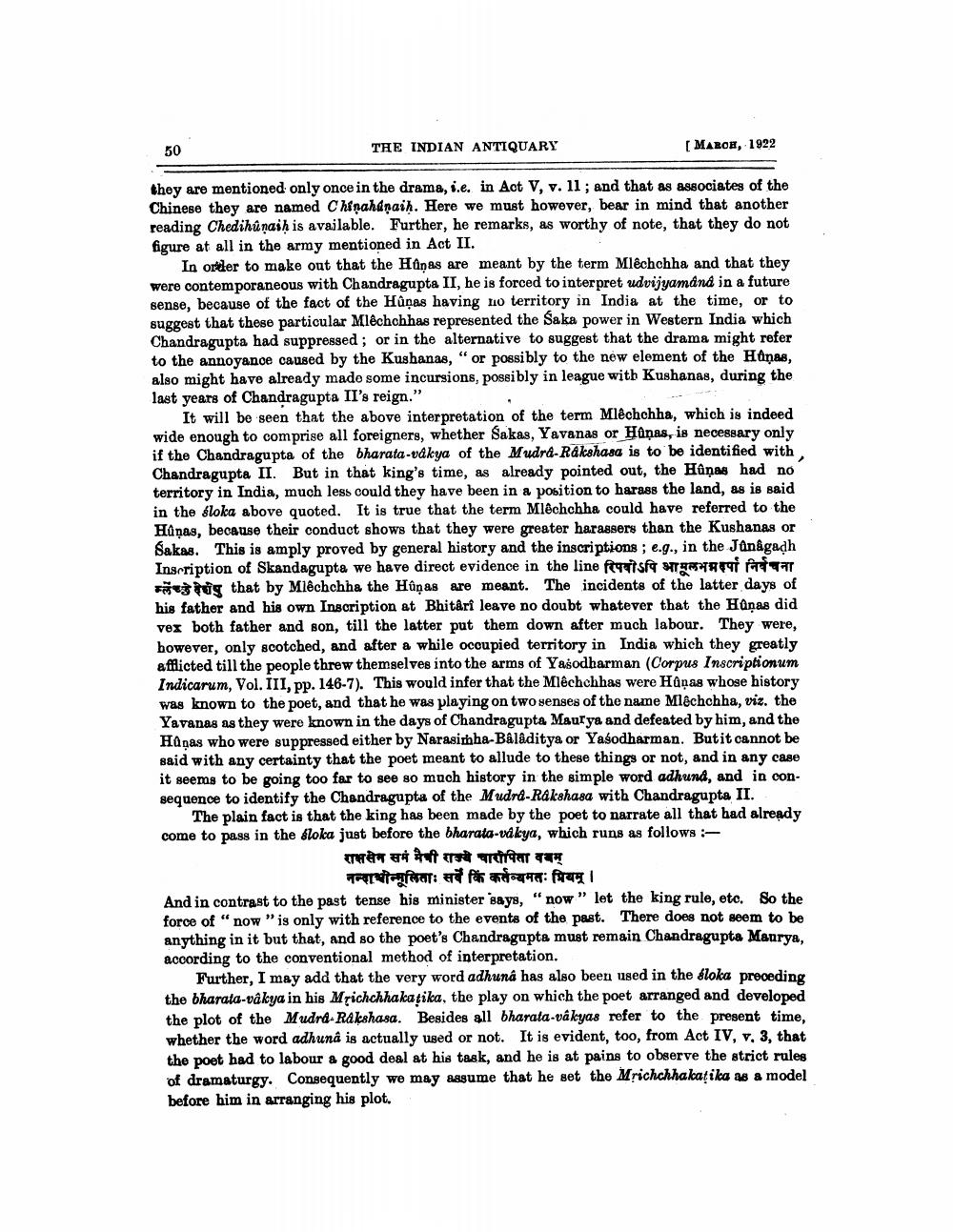________________
THE INDIAN ANTIQUARY
[MAROH, 1922
they are mentioned only once in the drama, i.e. in Act V, v. 11 ; and that as associates of the Chinese they are named Chinahaņaih. Here we must however, bear in mind that another reading Chedihûnaiḥ is available. Further, he remarks, as worthy of note, that they do not figure at all in the army mentioned in Act II.
In order to make out that the Hðņas are meant by the term Mléchchha and that they were contemporaneous with Chandragupta II, he is forced to interpret udvijyamand in a future sense, because of the fact of the Hûnas having no territory in India at the time, or to suggest that these particular Mlêchchhas represented the Saka power in Western India which Chandragupta had suppressed; or in the alternative to suggest that the drama might refer to the annoyance caused by the Kushanas, " or possibly to the new element of the Hôņas, also might have already made some incursions, possibly in league with Kushanas, during the last years of Chandragupta II's reign."
It will be seen that the above interpretation of the term Mlêchchha, which is indeed wide enough to comprise all foreigners, whether Sakas, Yavanas or Hûnas, is necessary only if the Chandragupta of the bharata-udkya of the Mudrd-Rakshasa is to be identified with Chandragupta II. But in that king's time, as already pointed out, the Hûņas had no territory in India, much less could they have been in a position to harass the land, as is said in the sloka above quoted. It is true that the term Mléchchha could have referred to the Hàņas, because their conduct shows that they were greater harassers than the Kushanas or Sakas. This is amply proved by general history and the inscriptions ; e.g., in the Jônagadh Inscription of Skandagupta we have direct evidence in the line रिपवोऽपि आमलभन्न निर्वचना
tug that by Mléchchha the Hûņas are meant. The incidents of the latter days of his father and his own Inscription at Bhitêrî leave no doubt whatever that the Hanas did vex both father and son, till the latter put them down after much labour. They were, however, only scotched, and after a while occupied territory in India which they greatly afflicted till the people threw themselves into the arms of Yasodharman (Corpus Inscriptionum Indicarum, Vol. III, pp. 146-7). This would infer that the Mlêchchhas were HQņas whose history was known to the poet, and that he was playing on two senses of the name Mléchchha, viz. the Yavanas as they were known in the days of Chandragupta Maurya and defeated by him, and the HQņas who were suppressed either by Narasimha-Bâladitya or Yasodharman. Butit cannot be said with any certainty that the poet meant to allude to these things or not, and in any case it seems to be going too far to see so much history in the simple word adhund, and in consequence to identify the Chandragupta of the Mudrd-Rakshasa with Chandragupta II.
The plain fact is that the king has been made by the poet to narrate all that had already come to pass in the bloka just before the bharata-udkya, which runs as follows:
रामसेन सम मैची राज्ये चारोपिता ववम्
नन्दाचीन्मूलिताः सर्वे किं कर्तब्धमतः प्रियम् । And in contrast to the past tense his minister says, "now" let the king rule, etc. So the force of "now" is only with reference to the events of the past. There does not seem to be anything in it but that, and so the poet's Chandragupta must remain Chandragupta Maurya, according to the conventional method of interpretation.
Further, I may add that the very word adhuna has also been used in the sloka preceding the bharata-vákya in his Msichchhakatika, the play on which the poet arranged and developed the plot of the Mudrd-Rakshasa. Besides all bharata-vákyas refer to the present time, whether the word adhuna is actually used or not. It is evident, too, from Act IV, v. 3. that the poet had to labour a good deal at his task, and he is at pains to observe the strict rules of dramaturgy. Consequently we may assume that he set the Mrichchhakatika as a model before him in arranging his plot.




